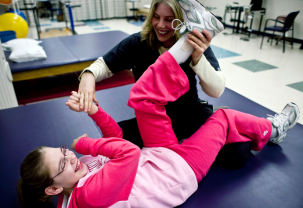Benefits of Yoga for Kids with Cerebral Palsy
Cerebral palsy is a neurological disorder which can cause limitations when it comes to movement, balance, speech, and more. Yoga is a form of exercise which emphasizes physical activity and mastery of both the body and mind. For many children with cerebral palsy, yoga can help alleviate some of the physical (and even mental) challenges they face on a daily basis.
Yoga incorporates a series of stretches done in sync with breathing exercises to help “reset” different body systems, stretch muscles and tendons, as well as tone muscle groups across the body. It is gentle, and can be done by people of virtually all ages, making it an ideal form of treatment for children with cerebral palsy who may suffer from a limited range of movement, as well as difficulty performing (or understanding complex instructions associated with) more mainstream exercises.
Some of the benefits of yoga for cerebral palsy include:
- It improves muscle tone
- It boosts flexibility
- It can give the child a sense of inner peace and confidence
- It relieves chronic pain due to muscle stiffness
- It helps improve bone structure and density
- It boosts lung capacity as well as blood circulation
An added advantage of yoga is the fact that it helps the child learn ways of relaxing and letting go, especially when they face times when their muscles stiffen for hours or days at a time. In short, it helps children with cerebral palsy lean into and accept their condition, while helping them identify their limitations and work toward improving flexibility and alleviating pain and discomfort.
Some yoga poses, also known as “asanas,” can even help realign the spine, helping send electrical signals to muscles so they can contract and relax more accurately. For most kids with Cerebral Palsy who have to contend with either stiff or very relaxed muscles, this can mean a world or difference, but understand that experiences do vary.
Additionally, yoga helps children develop a wider range of movement as well as improved hand-eye coordination, which may just be what they need to gain more autonomy moving forward.
Adaptive Yoga for Cerebral Palsy
Given the special needs of children with cerebral palsy, one should not expect these kids to carry out complex yoga poses such as head stands. Adaptive yoga takes regular poses and reworks them for people with disabilities, and is ideal for kids with Cerebral Palsy. For instance, some children may need their hands and/or legs guided as they try different yoga poses since they may not be able to do this on their own.
Many instructors offer adaptive yoga programs for children, and can help them learn yoga at a pace that’s comfortable for them. If you have particular concerns about your child’s abilities, discuss them with the instructor, ask about their experience with cerebral palsy, and see if they have recommendations. We strongly recommend consulting with a few yoga studios/instructors in your area to find the best fit for your child’s needs.

